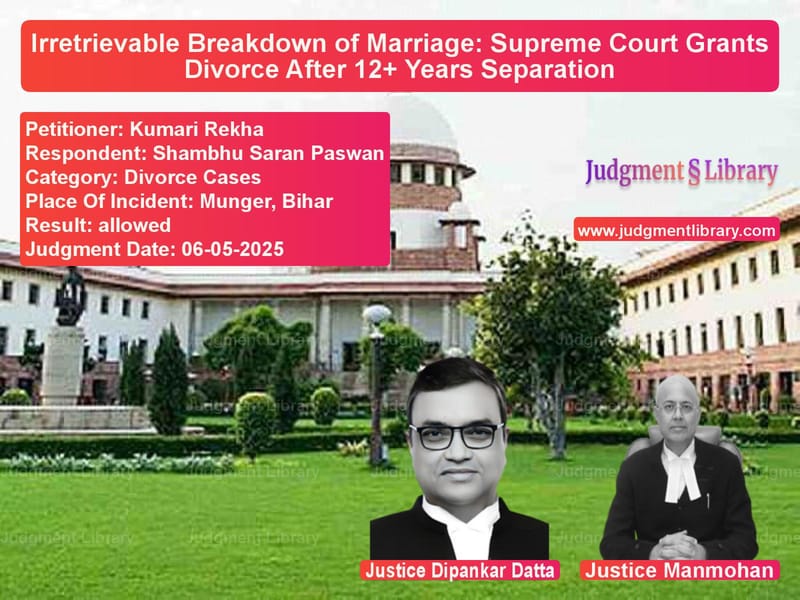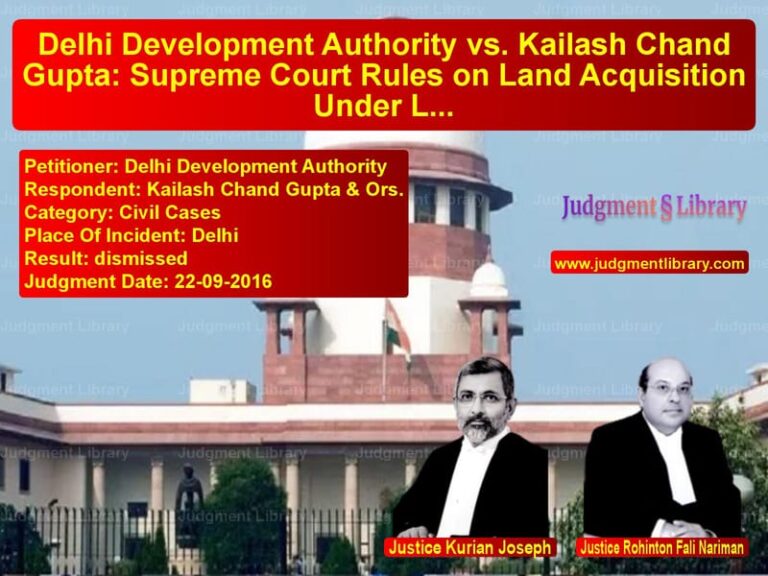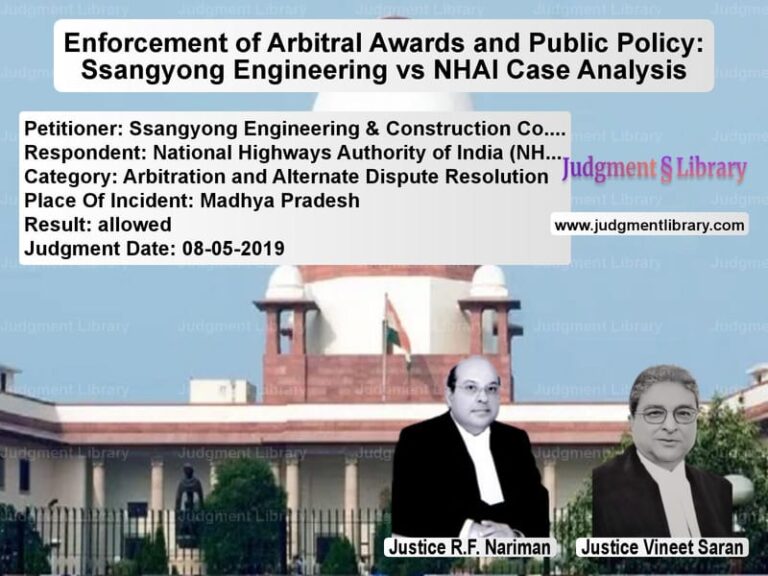Irretrievable Breakdown of Marriage: Supreme Court Grants Divorce After 12+ Years Separation
In a significant ruling that highlights the evolving approach to marital relationships in India, the Supreme Court recently exercised its extraordinary constitutional powers to dissolve a marriage that had effectively ended over a decade ago. The case of Kumari Rekha vs. Shambhu Saran Paswan presented a classic example of a marriage that existed only on paper, with the parties having lived separately for more than twelve years and showing no possibility of reconciliation.
The appeal before the Supreme Court challenged the judgment of the Patna High Court, which had upheld the Family Court’s decision dismissing the wife’s petition for divorce while allowing the husband’s petition for restitution of conjugal rights. This created a legal impasse where the wife sought dissolution of the marriage while the husband insisted on continuing the marital relationship, despite their prolonged separation.
The Marital Background
The marriage between Kumari Rekha (the appellant-wife) and Shambhu Saran Paswan (the respondent-husband) was solemnized on April 24, 1999. The couple was blessed with a daughter on June 7, 2001. However, the marriage eventually soured, and the parties began living separately. The exact date of separation was disputed—the wife claimed they had been living separately since 2008, while the husband contended the separation began in 2012. Regardless of this discrepancy, both parties acknowledged that they had been living apart for at least twelve years by the time the matter reached the Supreme Court.
The Wife’s Plea for Freedom
Ms. Nivedita Nirvikar, learned senior counsel for the appellant-wife, presented compelling arguments for granting divorce. She ruled out any scope for such reconciliation and insisted for a decree of divorce on the ground of irretrievable breakdown of marriage. Ms. Nirvikar emphasized that because of the acrimony between the parties, there is nothing left of the marriage.
Addressing the concerns about their daughter, Ms. Nirvikar informed the Court that the child of the parties has since grown up and she is an adult, pursuing her medical course in Puducherry. She countered the husband’s claims of involvement in their daughter’s life by stating that the respondent-husband never cared for his child and all expenses for her up-bringing as well as education have been borne by the appellant-wife.
Regarding the husband’s claims about supporting her career, Ms. Nirvikar asserted that she was an aspirant for public employment even before her marriage. She emphasized that with great deal of personal effort and without anyone’s assistance she could secure public employment. She characterized the husband’s submissions to the contrary as entirely wrong.
The Husband’s Resistance
Mr. Ashok Kumar Choudhary, learned senior counsel for the respondent-husband, presented equally strong arguments against granting divorce. He submitted, on instructions, that the respondent-husband was more than willing to have resumption of marital relationship particularly having regard to the future of the child of the parties.
Mr. Choudhary painted a picture of betrayal, contending that the petitioner-wife started showing her true colours once she obtained public employment. He claimed that the respondent-husband had huge contributions for what the appellant-wife is today (she happens to be a Child Development Project Officer). According to his narrative, not only was she encouraged by him to prepare for securing public employment, the entire expenses for her to live a dignified, fulfilling and meaningful life were borne by him. He alleged that conveniently, she repudiated the contribution of the respondent-husband and disowned him after such employment.
Mr. Choudhary raised significant concerns about the social implications of divorce, particularly for their daughter. He argued that in light of the socio-economic conditions of the rural area from where the respondent-husband hails, it would be extremely difficult, if not impossible, to find a suitable groom for his child. He expressed worry that having regard to the stigma that is attached with a divorce, no respectable family would agree to give in marriage their son with the child of a divorcee.
Mr. Choudhary assiduously urged that this appeal be dismissed, relying on several decisions of the Supreme Court and arguing that it has not been demonstrated how the Family Court or the High Court erred in not granting relief to the appellant-wife.
The Court’s Innovative Approach
Faced with these conflicting narratives and concerns, the Supreme Court bench comprising Justices Dipankar Datta and Manmohan adopted an innovative approach. The Court noted that we heard rival contentions of the parties with patience and considering that the respondent-husband was overly concerned about his child’s future, particularly about her married life, decided to interact with her on the virtual platform.
This direct interaction with the parties’ daughter revealed that she was in her second year of MBBS course in a medical college in Puducherry and was approaching marriageable age. Most importantly, the Court found her sufficiently mature to make her own decisions. While the judgment doesn’t detail the specific conversation, it’s clear that the daughter’s perspective significantly influenced the Court’s final decision.
The Constitutional Power of Article 142
The Supreme Court invoked its extraordinary powers under Article 142 of the Constitution of India, which enables it to pass any decree or order necessary for doing complete justice in any matter pending before it. The Court explicitly stated: We need not burden this judgment with what the child of the parties answered while responding to the other questions posed to her by both of us. Suffice to record, we believe that it is a fit case for us to invoke powers conferred on us by Article 142 of the Constitution of India and to dissolve the marriage between the parties on the ground of irretrievable breakdown of marriage.
The Court explained its reasoning: We are persuaded to do so, having considered the prolonged period of separation and the multiple failed attempts at reconciliation, which clearly indicate that there is no possibility of reunion, as well as their age (both are quinquagenarian).
The Court addressed the husband’s continued resistance: Mr. Choudhary for the respondent-husband once again urged us to not grant divorce as it would not be in the best interest of the child. We are not impressed by this submission, especially in light of the fact that the respondent-husband and his daughter have had no contact during the entire period of separation. To us, this appears to be a mere attempt to prolong the litigation and stall the inevitable.
Legal Precedent and Final Decision
The Court referenced the landmark Constitution Bench decision in Shilpa Sailesh v. Varun Sreenivasan to support its approach. It noted: Even though the respondent-husband has vehemently opposed the prayer for dissolution of marriage contending that none of the available grounds on which a Hindu marriage could be dissolved is present, the same is not a bar for us to exercise our powers under Article 142 of the Constitution; more particularly when we are satisfied that it is a case of irretrievable breakdown of marriage.
In its concluding observations, the Court expressed its broader perspective: Keeping in mind the totality of the facts and circumstances, we are of the clear view that it would be in the best interest of both the parties, and their daughter too, to put a quietus to this protracted litigation. It is our hope that this quietus allows all members of the family to move on in life.
The Final Outcome
The Supreme Court allowed the appeal and dissolved the marriage by a decree of divorce. Since the appellant-wife had no claim for alimony, no order was made in that regard. The Court’s decision represents a significant application of the principle of irretrievable breakdown of marriage, even in the face of opposition from one spouse.
Broader Implications
This judgment continues the Supreme Court’s evolving jurisprudence on irretrievable breakdown of marriage as a ground for divorce. While the Hindu Marriage Act does not explicitly include irretrievable breakdown as a ground for divorce, the Supreme Court has increasingly used its constitutional powers under Article 142 to grant divorce in cases where marriages have clearly ended in fact, if not in law.
The Court’s approach in this case is particularly noteworthy for several reasons. First, it directly engaged with the child of the marriage who had reached adulthood, recognizing her maturity and agency in matters affecting her family. Second, it prioritized practical reality over technical legal arguments about whose fault caused the marriage breakdown. Third, it acknowledged that prolonging a dead marriage serves no one’s interests—not the spouses, and certainly not the children.
The judgment also highlights the social changes in Indian society, where the stigma associated with divorce is gradually diminishing, especially among educated, urban populations. The Court implicitly recognized this when it rejected the husband’s argument about difficulties in finding a suitable match for their daughter, who was pursuing a medical degree and clearly capable of making her own life decisions.
This case serves as an important precedent for similar situations where marriages have effectively ended years ago, but legal technicalities prevent formal dissolution. It reaffirms the Supreme Court’s role as an institution that delivers substantive justice, not just procedural correctness.
As Indian society continues to evolve, and as more women achieve economic independence and educational attainment, the concepts of marriage, divorce, and family relationships are inevitably transforming. Judgments like this one acknowledge these social realities while balancing them with legal principles and constitutional values.
Petitioner Name: Kumari Rekha.Respondent Name: Shambhu Saran Paswan.Judgment By: Justice Dipankar Datta, Justice Manmohan.Place Of Incident: Munger, Bihar.Judgment Date: 06-05-2025.Result: allowed.
Don’t miss out on the full details! Download the complete judgment in PDF format below and gain valuable insights instantly!
Download Judgment: kumari-rekha-vs-shambhu-saran-paswan-supreme-court-of-india-judgment-dated-06-05-2025.pdf
Directly Download Judgment: Directly download this Judgment
See all petitions in Mutual Consent Divorce
See all petitions in Alimony and Maintenance
See all petitions in Property Division in Divorce Cases
See all petitions in Judgment by Dipankar Datta
See all petitions in Judgment by Manmohan
See all petitions in allowed
See all petitions in supreme court of India judgments May 2025
See all petitions in 2025 judgments
See all posts in Divorce Cases Category
See all allowed petitions in Divorce Cases Category
See all Dismissed petitions in Divorce Cases Category
See all partially allowed petitions in Divorce Cases Category







